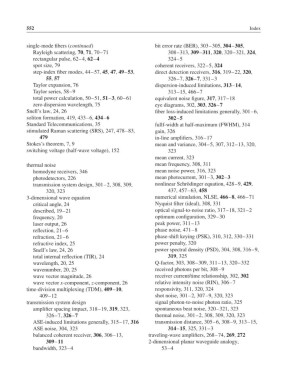Page 571 - Fiber Optic Communications Fund
P. 571
552 Index
single-mode fibers (continued) bit error rate (BER), 303–305, 304–305,
Rayleigh scattering, 70, 71, 70–71 308–313, 309–311, 320, 320–321, 324,
rectangular pulse, 62–4, 62–4 324–5
spot size, 79 coherent receivers, 322–5, 324
step-index fiber modes, 44–57, 45, 47, 49–53, direct detection receivers, 316, 319–22, 320,
55, 57 326–7, 326–7, 331–3
Taylor expansion, 76 dispersion-induced limitations, 313–14,
Taylor series, 58–9 313–15, 466–7
total power calculation, 50–51, 51–3, 60–61 equivalent noise figure, 317, 317–18
zero dispersion wavelength, 75 eye diagrams, 302, 303, 326–7
Snell’s law, 24, 26 fiber loss-induced limitations generally, 301–6,
soliton formation, 419, 433–6, 434–6 302–5
Standard Telecommunications, 35 fullf-width at half-maximum (FWHM), 314
stimulated Raman scattering (SRS), 247, 478–83, gain, 326
479 in-line amplifiers, 316–17
Stokes’s theorem, 7, 9 mean and variance, 304–5, 307, 312–13, 320,
switching voltage (half-wave voltage), 152 323
mean current, 323
thermal noise mean frequency, 308, 311
homodyne receivers, 346 mean noise power, 316, 323
photodetectors, 226 mean photocurrent, 301–3, 302–3
transmission system design, 301–2, 308, 309, nonlinear Schrödinger equation, 428–9, 429,
320, 323 437, 457–63, 458
3-dimensional wave equation numerical simulation, NLSE, 466–8, 466–71
critical angle, 24 Nyquist filter (ideal), 308, 331
described, 19–21 optical signal-to-noise ratio, 317–18, 321–2
frequency, 20 optimum configuration, 329–30
laser output, 26 peak power, 311–13
reflection, 21–6 phase noise, 471–8
refraction, 21–6 phase-shift keying (PSK), 310, 312, 330–331
refractive index, 25 power penalty, 320
Snell’s law, 24, 26 power spectral density (PSD), 304, 308, 316–9,
total internal reflection (TIR), 24 319, 325
wavelength, 20, 25 Q-factor, 303, 308–309, 311–13, 320–332
wavenumber, 20, 25 received photons per bit, 308–9
wave vector magnitude, 26 receiver current/time relationship, 302, 302
wave vector x-component, z-component, 26 relative intensity noise (RIN), 306–7
time-division multiplexing (TDM), 409–10, responsivity, 311, 320, 324
409–12 shot noise, 301–2, 307–9, 320, 323
transmission system design signal photon-to-noise photon ratio, 325
amplifier spacing impact, 318–19, 319, 323, spontaneous beat noise, 320–321, 323
326–7, 326–7 thermal noise, 301–2, 308, 309, 320, 323
ASE-induced limitations generally, 315–17, 316 transmission distance, 305–6, 308–9, 313–15,
ASE noise, 304, 323 314–15, 325, 331–3
balanced coherent receiver, 306, 306–13, traveling-wave amplifiers, 268–74, 269, 272
309–11 2-dimensional planar waveguide analogy,
bandwidth, 323–4 53–4

